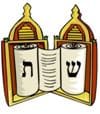



After the tragic events of 2nd October, CST felt it is important to provide a security awareness session
to all communal shul rota security volunteers, shul executive members and Rabbonim.
Attending regular security briefings and training is critical to providing the best security possible to our community
and ensuring our shul security rotas teams are fully briefed on up-to-date methods and procedures.
This training session will take place at Stenecourt Synagogue, on
NEXT Thursday 27th November 2025,
doors open at 19.30 hrs.
All attendees must register,
this can be done directly via an email to
*******


לוח זמני תפלה לחורף תשפ״ו
Winter Timetable 5786 – 2025/26
מוצאי שבת | ערבית (מוצ״ש) | שקיעה | מנחה שבת | סוף זמן קריאת שמע | הדלקת נרות | מנחה וקבלת שבת | תאריך | שבת פרשת |
Shabbat Ends | Arbit | Sunset | Minha | Shema before | Candle Lighting | Minha & Kabbalat Shabbat | Date | Parasha |
PM | PM | PM | PM | AM | PM | PM |
|
|
4:58 | 4:54 | 4:01 | 3:25 | 9:51 | 3:48 | 3:48 | 21/22 Nov | תולדות |
*********
🕯️WINTER TIMES FOR SHABBAT MORNING🕯️
שבת
קרבנות
8:45 am
הודו
9:00 am
*****

*****
Moor Lane Women’s Nach Group

**********
After 20 years of marriage, Yitzchak’s prayers are answered and Rivka conceives twins. The pregnancy is extremely painful. Hashem reveals to Rivka that the suffering is a microcosmic prelude to the worldwide conflict that will rage between the two great nations descended from these twins, Rome and Israel. Esav is born, and then Yaakov, holding on to Esav’s heel. They grow, and Esav becomes a hunter, a man of the physical world, whereas Yaakov sits in the tents of Torah, developing his soul.
On the day of their grandfather Avraham’s funeral, Yaakov is cooking lentils, the traditional mourner's meal. Esav rushes in, ravenous from a hard day’s hunting, and sells his birthright (and its concomitant spiritual responsibilities) for a bowl of lentils, demonstrating his unworthiness for the position of firstborn.
A famine strikes Canaan and Yitzchak thinks of escaping to Egypt, but Hashem tells him that because he was bound as a sacrifice, he has become holy and must remain in the Holy Land. He relocates to Gerar in the land of the Philistines, where, to protect Rivka, he has to say she is his sister. The Philistines grow jealous of Yitzchak when he becomes immensely wealthy, and Avimelech the king asks him to leave. Yitzchak re-digs three wells that were dug by his father, prophetically alluding to the three future Temples. Avimelech, seeing that Yitzchak is blessed by Hashem, makes a treaty with him.
When Yitzchak senses his end approaching, he summons Esav to give him his blessings. Rivka, acting on a prophetic command that the blessings must go to Yaakov, arranges for Yaakov to impersonate Esav and receive the blessings. When Esav in frustration reveals to his father that Yaakov has bought the birthright, Yitzchak realizes that the birthright has been bestowed correctly on Yaakov and confirms the blessings he has given Yaakov. Esav vows to kill Yaakov, and so Rivka sends Yaakov to her brother Lavan where he could find a suitable wife.
Ohr Somayach Institutions www.ohr.edu

דין ישיבה בתוך ארבע אמות של המתפלל
הרבה מן ההלכות הנוגעות לתפלה, למדו רבותינו מן המעשה המובא בתחילת ספר שמואל, אודות חנה, אמו של שמואל הרמתי, שהלכה לבית המקדש והתפללה לפני ה' שיזכה אותה בפרי בטן. ואכן מכח תפלתה נולד לה בנה הקדוש, הוא הנביא שמואל.
והנה אין חילוק בזה אם בא לשבת לפני המתפלל, או בצדדיו, שכל שהוא בתוך ארבע אמות של המתפלל אסור לשבת שם, אלא ירחיק מעט יותר מארבע אמות, ואז רשאי לשבת. ופשוט שאין חילוק בזה אם המתפלל הוא איש, או שהיא אשה שמתפללת, שבכל אופן אסור לשבת בתוך ארבע אמותיו של המתפלל.
ורבינו הטור כתב, שהטעם הוא מפני שנראה הדבר כאילו חבירו מקבל עליו עול מלכות שמים, ואילו הוא יושב בטל בשלוות נפש ואינו מקבל עליו עול מלכות שמים.
והרב רבינו המאירי כתב, שטעם האיסור הוא כדי שלא יתבלבל המתפלל בשעת תפילתו מחמת הסובבים אותו. ועוד כתב בספר המכתם, שאסור לשבת סמוך למתפלל, כדי שלא יתבייש המתפלל מחבירו שרואה שהוא בוכה בתפילתו.
ולהלכה, רבינו הרמב”ם (בפ”ה מהלכות תפלה) כתב, שאסור לישב “בצד העומד בתפלה”. ומשמע קצת שמאחוריו רשאי לשבת. וכן מרן השלחן ערוך (סימן קב) כתב, שאסור לישב בתוך ארבע אמות של המתפלל “בין מלפניו בין מן הצדדין”, ומשמע קצת שמאחריו מותר. וכן כתבו כמה מגדולי האחרונים, שלדעת מרן השלחן ערוך, מותר לשבת מאחורי המתפלל. אולם יש מחמירים בדבר. הלכך, המחמיר שלא לשבת מאחורי המתפלל, תבא עליו ברכה. ולמנהג האשכנזים יש לאסור בזה בפשיטות, שלא לשבת מאחורי אדם המתפלל, שכן פסק בפירוש רבינו הרמ”א, שבני אשכנז קבלו הוראותיו.
ולסיכום: אסור לשבת בסמוך לארבע אמותיו (שני מטר) של המתפלל תפילת העמידה. בין מלפניו, ובין מצדדיו. ויש מחמירים בזה אף כשהוא יושב מאחורי המתפלל. והוא הדין שאסור לשבת בסמוך לשליח ציבור בשעה שהוא מתפלל.
Sitting Within Four Amot of One Praying
Our Sages derived many laws pertaining to prayer from the incident recorded in the beginning of the book of Shmuel regarding Chana, mother of Shmuel Ha’Navi, who went to the Mishkan (Tabernacle) in Shilo in order to pray to Hashem that she be able to bear children. Through the power of her prayer, he holy son, Shmuel Ha’Navi, was born.
The Prohibition to Sit in Close Proximity of One Praying
Our Sages (Berachot 31b) learned from what Chana told Eli Ha’Kohen while she was praying, “I am the woman standing with you here to pray to Hashem,” that one may not sit within four Amot of one praying Amida. Four Amot is equal to approximately 6.5 feet.
There is no distinction whether one wishes to sit in front or on the side of one praying, for as long as one is within four Amot of one praying, one may not sit there; rather, one should move slightly more than four Amot of the individual praying, at which point one may be seated. Clearly, there is no difference whether the individual praying is a man or woman and the prohibition to sit within their four Amot remains the same.
The Reason for this Prohibition
Our Sages disagree regarding the reason why sitting within four Amot of one praying is forbidden. The Ba’al Halachot Gedolot writes that the reason for this is because Hashem’s presence rests within four Amot of one praying and sitting there is therefore disrespectful. It seems that according to the holy Zohar, the reason is likewise due to respect for the presence of Hashem.
The Tur writes that the reason for this prohibition is because it seems that while one individual is accepting the sovereignty of Hashem upon himself, this individual is sitting idly and complacently and not accepting Hashem’s kingship.
The Meiri writes that the reason for this prohibition is in order for the concentration of the one praying not to be disturbed by those around him. The Sefer Ha’Michtam adds that the reason is in order for the individual praying not to be ashamed by the fact that the person sitting next to him sees him crying while he is praying.
Sitting Behind One Praying
Regarding sitting behind one praying, this would be contingent on the aforementioned reasons. If the reason why it is forbidden to sit close to one praying is out of reverence for the presence of Hashem, this should be forbidden even when one sits behind one who is praying. However, if the reason is for the one praying not to be ashamed or disturbed, these reasons no longer apply when one sits behind the individual praying.
Halachically speaking, the Rambam (Chapter 5 of Hilchot Tefillah) writes that it is forbidden to sit “on the side of one praying.” It would seem from here that one may sit behind one praying. Similarly, Maran Ha’Shulchan Aruch rules that one may not sit within four Amot of one praying, “whether in front of him or on his side.” It would likewise seem from here that sitting behind him would be permissible. Indeed, some great Acharonim write that according to Maran Ha’Shulchan Aruch, one may sit behind one praying. Nevertheless, there are those who rule stringently on this matter. Thus, if one acts stringently and does not sit behind one praying, he shall surely be blessed. According to the Ashkenazi custom, sitting behind one praying is certainly forbidden, for this is how the Rama rules and Ashkenazim have accepted the Rama’s rulings.
Sitting in Close Proximity of the Chazzan
Based on the above, the same would apply to one who wishes to sit within four Amot of a Chazzan while he recites the repetition of the Amida and one will not be permitted to do so until he distances himself more than four Amot away from where the Chazzan is standing. Maran Rabbeinu zt”l points this out in his Responsa Yechave Da’at (Chapter 5) and writes that even those who act leniently and sit during the Chazzan’s repetition must make certain not to do so within four Amot of the Chazzan.
Summary: One may not sit within four Amot (6.5 feet) of one praying Amida, whether one is sitting in front of him or to his side. Some rule stringently regarding sitting behind one praying, as well. It is likewise forbidden to sit within four Amot of a Chazzan while he is reciting the repetition of the Amida.